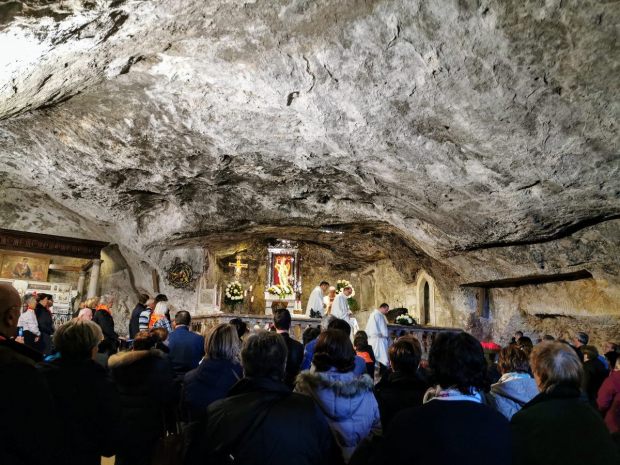Lenten Campaign 2025
This content is free of charge, as are all our articles.
Support us with a donation that is tax-deductible and enable us to continue to reach millions of readers.
The holy grotto on Italy's Gargano peninsula attracts thousands of pilgrims. Visitors must ascend a rather steep slope into the town. After passing through narrow streets, they reach the place that one of the archangels has visited personally.
Gargano. An extraordinary mountain dedicated to St. Michael the Archangel, on a peninsula of land surrounded by the Adriatic sea.
An illuminated white statue of Archangel Michael depicts him trampling Satan with his left foot. In his right hand he raises a sword, and with the smallest finger of his left hand, with a single link of chain, he completely controls the movements of the king of hell and does not allow him to move his head.
He "who stands always before God" has Satan in his little finger!

On September 29, 492, Bishop Lawrence celebrated the first Mass in the grotto on Gargano. On that day, the basilica was given the title of Celestial Basilica. At the time it was simply a cave, untouched by human hands, with no building on the surface.
It's said that Michael told the good bishop:
Such a generous promise from one of God's closest servants brought pilgrims from far and wide.
The first visitors encountered a difficult and dangerous path. The cave was located deep in the rock, and the entrance was overgrown. One had to climb over rocky protrusions, and in the depths of the cave, keep close to the left wall and place one's feet carefully, as the right side dropped nearly six meters (20 feet).
It wasn't until the 19th century that buildings were constructed in the massive rock above the cave, and a staircase was added, which today we can safely descend to the interior of the mountain.

Among the many who visited Michael's shrine over the years was St. Francis of Assisi.
When St. Francis arrived on Gargano in 1221, there were no buildings and no alabaster statue of Michael. Entering the grotto required stamina and courage. According to tradition, the Poor Man of Assisi climbed a dangerous section of rocky steps, but … he did not enter the grotto itself. The chronicles say that he did not feel worthy to stand in the place where the messenger from heaven had stood. And as proof that he had undertaken and completed the pilgrimage, at the entrance to the holy grotto, on the outer rock, he carved the sign of the Greek letter tau - T. This Old Testament sign of the cross was Francis' favorite signature.
St. Francis made the pilgrimage during Lent, shortly after the Fifth Crusade - which he joined to meet the Sultan - had failed. Above all, according to Francis, the failure was a moral one.
Francis, "a crusader without arms," made the pilgrimage to Gargano to stand before the archangel who wars against Satan, not man, under the slogan, "Who like God?!"
Upon his return to Assisi, Francis advised his brothers to fast and pray for forty days between the Ascension of Mary and the feast of St. Michael the Archangel, from August 15 to September 29. Why? Because he saw a close connection between Mary, Queen of Angels, and the Heavenly Warrior.
"Everyone, in honor of such a glorious Prince, should offer to God some special gift. For Blessed Michael should be venerated more solemnly, since his task is to present souls to God," he explained.
During one of these fasts, on September 14, 1224, Christ appeared to him on Mount La Verna and bestowed upon him the grace of the stigmata. Tradition has also handed down a tale in which the archangel Michael was present when Francis received Christ's Wounds.
The Archangel Michael, whose cult was already very much alive in Italy at the time of Francis, was viewed through the lens of Mary.
It was from her that Francis sought rescue in the most difficult cases, it was to her that he asked for help in his struggle with Satan. In Michael, for whom Mary was Queen, he saw a knight serving the same cause - the fight against sin and evil, not against mere mortals.

To use contemporary language, St. Francis was a great fan of the Archangel Michael. He trusted him so much that in the original rule of the order, he wrote that "every superior of the order should meet with his brothers every year on the feast of St. Michael the Archangel wherever he wishes, to discuss the things of God."
He considered the moment of passage of the soul, at the time of the death of the human body, to be the most important moment of life, determining eternity. In the presence of Michael, he saw the path to arrive safely to the arms of the Father.

Another apparition of St. Michael, from the 1600s, is linked to the shrine. This time, Michael was entreated for help because a pandemic was decimating the population of the area. Michael urged the bishop to bless the stones of the cave and distribute them. This was done and the plague faded away.
Since that time, stones from the cave have been kept as reminders of the angel's intercession.












